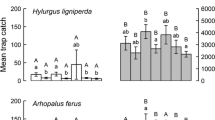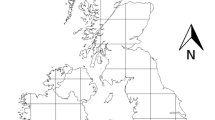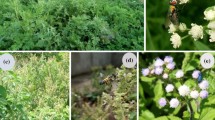Summary
The goldenrod leaf beetle, Trirhabda canadensis, is known to respond to odors of host and non-host species in the laboratory. Here we report movements of T. canadensis in the field in response to volatile odors from monocultures and polycultures of host plants. Overall, beetles preferentially colonized plots with a higher density of host plants and lower diversity of allelochemicals, but under some wind conditions there were marked exceptions. At high windspeeds, they colonized whichever plot(s) was upwind. At low windspeeds, beetles colonized preferred plots even when they were not upwind. The data suggest that odor dispersion varies in a complex way with windspeed: at low windspeeds beetles received information from a wide are of vegetation and made choices while at high windspeeds information was available only from upwind plot(s).
Similar content being viewed by others
References
Altieri MA, Letourneau DK (1982) Vegetation management and biological control in agroecosystems. Crop Prot 1:405–430
Andow DA (1986) Plant diversification and insect populations in agroecosystems. In: Pimentel D (ed) Some aspects of integrated pest management. Department of Entomology, Cornell University. Ithaca New York, pp 277–368
Atsatt PR, O'Dowd DJ (1976) Plant defense guilds. Science 193:24–29
Aylor DE (1976) Estimating peak concentrations of pheromones in the forest. In: Anderson JF, Kaya HK (eds) Perspectives in forest entomology. Academic Press, New York, pp 177–188
Aylor DE, Parlange J, Granett J (1976) Turbulent dispersion of Disparlure in the forest and male gypsy moth response. Environ Entomol 5:1026–1032
Bach CE (1980) Effects of plant density and diversity on the population dynamics of a specialist herbivore the striped cucumber beetle, Acalymma vittata (Fab). Ecology 61:1515–1530
Baker DG (1983) The climate of Minnesota: XIV-wind climatology and wind power. AD-TB1955. Technical Bulletin, Agricultural Experiment Station, University of Minnesota
Baker RJ, Nelder JA (1978) The GLIM system: release 3, manual. Numerical Algorithms Group, Oxford
Balduf WV (1929) The life history of the goldenrod beetle, Trirhabda canadensis Kirby (Coleoptera: Chrysomelidae). Entomol News 40:35–39
Bell WJ (1984) Chemo-orientation in walking insects. In: Bell WJ, Cardé RT (eds) Chemical ecology of insects. Sinauer, Sutherland, pp 93–110
Borden JH, Hunt DWA, Miller DR, Slessor KN (1986) Orientation in forest Coleoptera: an uncertain outcome of responses by individual beetles to variable stimuli. In: Payne TL, Birch MC, Kennedy CEJ (eds) Mechanisms in insect olfaction. Clarendon Press, Oxford, pp 97–110
Burrage SW (1978) Monitoring the environment. In: Scott PR, Bainbridge A (eds) Plant disease epidemology. Blackwell, Oxford London, pp 93–101
Campbell GS (1977) An introduction to environmental biophysics. Springer, Berlin Heidelberg New York
Cardé RT (1986) Epilogue: behavioural mechanisms. In: Payne TL, Birch MC, Kennedy CEJ (eds) Mechanisms in insect olfaction. Clarendon Press, Oxford, pp 175–186
Cooper-Driver GA, Do MN, Villani M, Le Quesne PW (1987) Diterpenoid constituents of Solidago nemoralis. J Nat Prod 50:327
Cromartie Jr WJ (1981) The environmental control of insects using crop diversity. In: Pimentel D (ed) CRC handbook of pest management, 1. CRC, Boca Raton, pp 223–251
Cronquist A (1980) Vascular flora of the southeastern United States, vol I: Asteraceae. University of North Carolina Press, Chapel Hill
Cushing EJ (1963) Late Wisconsin pollen stratigraphy of east-central Minnesota. Ph.D. thesis. University of Minnesota, Minneapolis, Minnesota
David CT, Kennedy JS, Ludlow AR (1983) Finding of a sex pheromone source by gypsy moths released in the field. Nature 303:804–806
de Wilde J (1976) The olfactory component in host-plant selection in the adult Colorado beetle (Leptinotarsa decelineata Say). Symp Biol Hung 16:291–300
Dickens JC, Boldt PE (1985) Electroantennogram responses of Trirhabda bacharides (Weber) (Coleoptera: Chrysomelidae) to plant volatiles. J Chem Ecol 11:767–779
Ehrlich PR, Raven PH (1964) Butterflies and plants: a study in coevolution. Evolution 18:586–608
Elkinton JS, Cardé RT (1984) Odor dispersion. In: Bell WJ, Cardé RT (eds) Chemical ecology of insects. Sinauer, Sutherland, pp 73–92
Fienberg SE (1980) The analysis of cross-classified categorical data, 2nd edn. M.I.T. Press, Cambridge
Grigal DF, Chamberlain LM, Finney HR, Wroblewski DV, Gross ER (1974) Soils of the Cedar Creek Natural History Area. Miscellaneous Report 123, University of Minnesota, St. Paul, Minnesota
Hawkes C (1974) Dispersal of adult cabbage rootfly (Eioischia brassica) in relation to a brassica crop. J Appl Ecol 11:83–93
Hegnauer R (1964) Chemotaxonomie der Pflanzen. Birkhauser, Basel Stuttgart
Heywood VH, Harborne JB, turner BL (1977) The biology and chemistry of the compositae, vol I, II. Academic Press, London
Hogue SM (1970) Biosystematics of the genus Trirhabda LeConte of America North of Mexico (Chrysomelidae: Coleoptera). PhD Dissertation. University of Idaho
Kareiva P (1983) Influence of vegetation texture on herbivore populations: resource concentration and herbivore movement. In: Denno RF, McClure MS (eds) Plants and herbivores in natural and managed systems. Academic Press, New York, pp 259–289
Kennedy JS (1986) Some current issues in orientation to odour sources. In: Payne TL, Birch MC, Kennedy CEJ (eds) Mechanisms in insect olfaction. Clarendon Press, Oxford, pp 11–26
Kramer E (1986) Turbulent diffusion and pheromone-triggered anemotaxis. In: Payne TL, Birch MC, Kennedy CEJ (eds) Mechanisms in insect olfaction. Clarendon Press, Oxford, pp 59–68
Le Quesne PW, Onan KD, Honkan V, Morrow PA, Tonkyn DW (1985) Oxidized kaurene derivatives from Solidago missouriensis Nutt. Phytochemistry 24:1785–1787
Le Quesne PW, Cooper-Driver GA, Villani M, Do MN, Morrow PA, Tonkyn DW (1986) Biologically active diterpenoids from Solidago species: plant-insect interactions. Stud Org Chem 26:271–282
Lower RL (1972) Effect of surrounding cultivar when screening cucumber for resistance to cucumber beetle and pickleworm. J Am Soc Hortic Sci 97:616–618
Maddala GS (1983) Limited dependent and qualitative variables in econometrics. Cambridge University Press, Cambridge
May MM, Ahmad S (1983) Host location in the Colorado Potato Beetle: searching mechanisms in relation to oligophagy. In: Ahmad S (ed) Herbivorous insects: host seeking behavior and mechanisms. Academic Press, New York, pp 173–199
McCullagh P, Nelder JA (1983) Generalized linear models. Chapman and Hall, New York
Melville MR, Morton JK (1982) A biosystematic study of the Solidago canadensis (Compositae) complex. I. The Ontario populations. Can J Bot 60:976–997
Messina FJ (1982a) Comparative biology of the goldenrod leaf beetles, Trirhabda virgata LeConte and T. borealis Blade (Coleoptera: Chrysomelidae). Coleopt Bull 36:255–269
Messina FJ (1982b) Timing of dispersal and ovarian development in goldenrod leaf beetles Trirhabda virgata and T. borealis. Ann Entomol Soc Am 75:78–83
Meyer MM (1981) Applications and generalizations of the iterative proportional fitting procedure. PhD thesis. University of Minesota, Minneapolis, Minnesota
Miller JR, Strickler KL (1984) Finding and accepting host plants. In: Bell WJ, Cardé RT (eds) Chemical ecology of insects. Sinauer, Sutherland, pp 127–158
Murlis J (1986) The structure of odor plumes. In: Payne TL, Birch MC, Kennedy CEJ (eds) Mechanisms in insect olfaction. Clarendon Press, Oxford, pp 27–38
Puttick GM, Morrow PA, Le Quesne PW (1988) Trirhabda canadensis (Chrysomelidae: Coleoptera) responses to plant odors. J Chem Ecol 14:1671–1686
Ralph CP (1977) Search behavior of the large milkweed bug, Oncopeltus fasciatus (Hemiptera: Lyaeidae). Ann Entomol Soc Am 70:337–342
Risch SJ, Andow D, Altieri MA (1983) Agroecosystem diversity and pest control: data, tentative conclusions and new research directions. Environ Entomol 12:625–629
Rosenberg NJ (1974) Microclimate: the biological environment. Wiley and Sons, New York
Saxena KM, Prabha S (1977) Relationship between the olfactory sensilla of Papilio demoleus L. larvae and their orientation responses to different odours. J Entomol Ser A 50:119–126
Scora RW (1967) Study of the essential leaf oils of the genus Monarda (Labiatae). Am J Bot 54:444–452
Seeley MW, Spoden GJ (1984, 1985, 1987) Crop season climatic data. University of Minnesota Cooperative for Agricultural Weather Advisory Program, University of Minnesota Agricultural Experimental Station, St. Paul
Snedecor GW, Cochran WG (1976) Statistical Methods, 6th edn. Iowa State University Press, Ames, Iowa
Sokal RR, Rohlf FJ (1981) Biometry, 2nd edn. W. H. Freeman, San Francisco
Stanton ML (1983) Spatial patterns in the plant community and their effects upon insect search. In: Denno RF, McClure MS (eds) Plants and nerbivores in natural and managed systems. Academic Press, New York, pp 125–157
Tahvanainen JO, Root RB (1972) The influence of vegetational diversity on the population ecology of a specialized herbivore, Phyllotreta cruciferae (Coleoptera: Chrysomelidae). Oecologia (Berlin) 10:321–346
Thiery D, Visser JH (1986) Masking of host plant odour in the olfactory orientation of the Colorado potato beetle. Entomol Exp Appl 41:165–172
Thorsteinson AJ (1960) Host selection in phytophagous insects. Annu Rev Entomol 5:193–218
Tilman GD (1984) Plant dominance along an experimental nutrient gradient. Ecology 65:1445–1453
Visser JH (1976) The design of a low-speed wind tunnel as an instrument for study of olfactory orientation in the Colorado beetle (Leptinotarsa decemlineata). Entomol Exp Appl 20:275–288
Visser PA, Nielson JK (1977) Specificity in the olfactory orientation of the Colorado beetle Leptinotarsa decemlineata. Entomol Exp Appl 21:12–22
Werner PA, Bradbury IK, Gross KS (1980) The biology of Canadian weeds. 45. Solidago canadensis L. Can J Plant Sci 60:1393–1409
Wolfenbarger DO (1975) Factors affecting dispersal distances of small organisms. Exposition Press, Hicksville
Author information
Authors and Affiliations
Rights and permissions
About this article
Cite this article
Morrow, P.A., Tonkyn, D.W. & Goldburg, R.J. Patch colonization by Trirhabda canadensis (Coleoptera: Chrysomelidae): effects of plant species composition and wind. Oecologia 81, 43–50 (1989). https://doi.org/10.1007/BF00377008
Received:
Accepted:
Issue Date:
DOI: https://doi.org/10.1007/BF00377008




